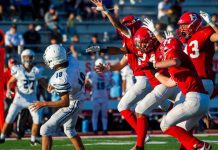
Darrin Gillies could not have asked for a better start to his professional baseball career. On Tuesday night, Gillies was pitching in the Midwest League All-Star Game. The next morning, he was on a flight to join his new team, the Bakersfield Blaze. Gillies went from the low-A level to the high-A ball level in half a season. The timing was fortuitous for Gillies, who still has roots in Hollister.
Bakersfield opens the first of a three-game set at the San Jose Giants on Monday.
After getting selected by the Seattle Mariners in the 10th round of the 2015 Major League Baseball Draft, Gillies was assigned to the team’s short-ball rookie league team, the Everett Aquasox.
The 2011 San Benito High graduate and former Arizona State University standout was then assigned to the team’s low-A team, the Clinton LumberKings of Iowa to start this season. All Gillies did in a relief role was go 5-2 with a 1.19 ERA, 0.80 WHIP, a .159 average against and 39 strikeouts in 38 innings.
Gillies’ performance earned him a spot in the Midwest League All-Star Game that was played in Cedar Rapids, Iowa Tuesday. Clinton has already clinched a playoff berth by virtue of finishing among the top two teams in the first half of the Midwest League Western Division standings with a 39-31 record.
The top two teams from the first half of the season and the top two from the second half earn spots in the postseason. Gillies, in his typical humble fashion, said the team’s success helped him receive All-Star recognition. The LumberKings were on the road when the All-Star rosters were announced.
“The manager came in for a team meeting and called us four (Gillies and three of his teammates got selected) to the front of the room to say we had been selected to the All-Star Game,” Gillies said. “There was a round of applause and a lot of hugs, and it was pretty cool to be a part of.”
The 23-year-old Gillies has come to enjoy the grind of minor league baseball, both mentally and physically. Mentally, the 6-foot-4, 220-pound Gillies said he hasn’t taken the individual approach that most players have once they start their career in the minors.
Players, of course, are looking to get to the majors as quick as possible, and because of that there are dozens of roster moves throughout the season. However, Gillies decided to have a team-approach focus, reasoning that it would help both him and the team.
“Coming from college to professional baseball, the biggest difference is the individual aspect,” he said. “The biggest change for some guys is not being so into the team, but my goal coming in was to help this team in any way, get to the playoffs and help the team win the Midwest League championship. One of the biggest things I learned in college is to control what you can control. Wherever I got assigned, I wanted to compete at the highest level and let those other things (All-Star selection, possible promotion) take care of themselves.”
Gillies has done just that in a relief role. Because he pitches one or two innings at a time, Gillies has been able to rely more on two pitches: his fastball and slider. When Gillies was a starter in college, he utilized a slider as well. But this season Gillies has been able to pitch off his fastball, making him ultra effective.
“This year I cleaned up my mechanics and am able to locate my fastball,” he said. “I can go in, out and up and throw it for strikes. In the past, I had to pitch off my breaking stuff. This year I was able to get fastball command back, and that has opened up doors for me to get ahead of hitters and put them away. By knowing I would be in the bullpen, I was able to get honed in and locked in.”
Gillies knew what life in the minors would like: being at the ballpark every single day, long bus rides and quick turnarounds. The constant travel time is not for the weary or weak. Gillies vividly recalls the longest trip of the season, starting on April 26 when the team had a 9 ½ hour trip to Bowling Green, Ky., for a three-game series.
At the conclusion of that series on the 28th, the team traveled overnight another five or six hours to Dayton, Ohio, for another three-game set.
After the third game in Ohio, on May 1, the team traveled another seven or eight hours back to Clinton for a home game the very next day. It’s pretty typical for a minor league team to finish a night game around 10 p.m., handle media and other duties before packing the bus and leaving around 11 or 11:30 to get to their next destination around 3 or 4 a.m. Then the players have to be at the ballpark by 1 p.m. the same day.
“When you sign up for this job, you better get ready for the grind because it’s no joke,” Gillies said. “There are a lot of late night bus rides. You stay in different hotels and sleeping in different places three to four times a week isn’t odd for the job we’re doing. It’s a grind, but the best part about it is you have 25 other teammates and coaches doing it with you. It’s a fun thing to be a part of a journey like this. This is something I’ve always wanted to do, so I can’t complain.”









